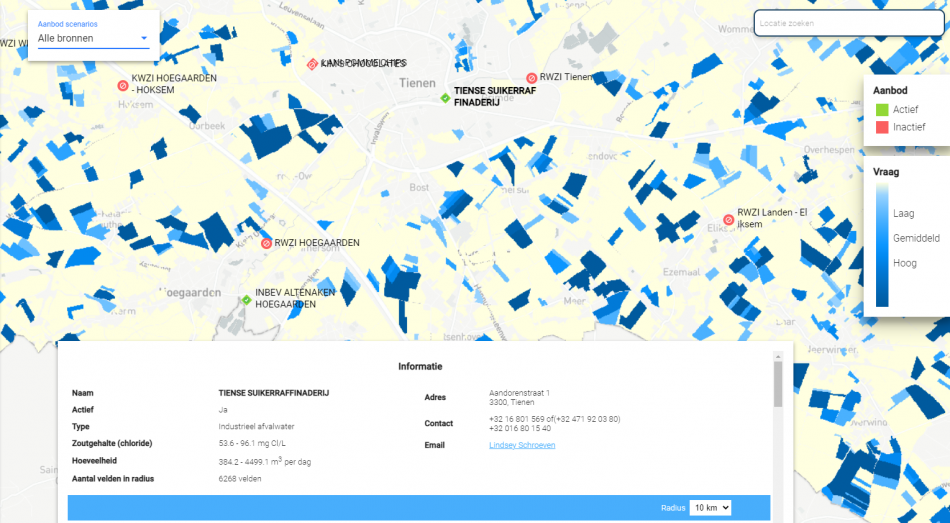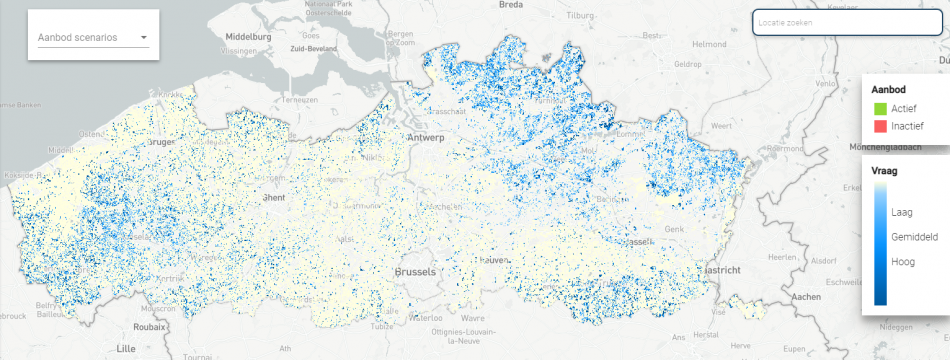On the occasion of World Water Day on Monday 22 March, Inagro, ILVO, VITO and Vlakwa launched the online viewer WaterRadar (www.waterradar.be). With this tool, farmers and horticulturalists can easily look for suitable alternative water sources in the vicinity of their fields. Specifically, the focus is on both treated household wastewater from Aquafin installations and treated wastewater from food processing companies. In addition, interested companies and local authorities can use this tool to gain insight into the theoretical irrigation needs on a regional scale.
Active and non-active water sources
By entering a location or address in the search function, growers can easily find out which alternative water sources are available in the surrounding area. The viewer shows, among other things, the address and contact details of the water supplier, as well as the average available daily volume (expressed in m3) and the chloride concentration of the water offered.
In order to be able to offer treated wastewater for agricultural use, both Aquafin treatment plants and food processing companies must have a resource certificate. The green companies in the WaterRadar are locations that have such a resource certificate. They are therefore legally in order to offer water. Red companies, on the other hand, do not yet offer water. But what is not possible today, may be possible tomorrow.
Screenshot of the WaterRadar zoomed in on the region around the Tienen sugar refinery, which has a resource certificate to offer treated wastewater in practice. Other active (green) and inactive (red) water sources in the area are also mapped.
Theoretical irrigation demand visualised for 2020
Besides the water supply, the WaterRadar also visualises the theoretical irrigation demand on a regional scale. To this end, the project partners mapped the present crops on the plots all over Flanders for 2020. For each crop (group), they then made a rough estimate of the extra irrigation needed for the entire growing season, on top of the natural precipitation. In doing so, they assumed a normal weather pattern (and thus not the extremes of the past three years). The map shows at a glance in which regions the potential water demand is highest.
The WaterRadar gives a general picture of the theoretical water demand on a regional scale. This map is based on the occurring crops from the most recent collection application and a rough estimation of the area-specific irrigation need per crop.
Companies that want to offer water to farmers and horticulturalists can use the WaterRadar to verify the potential demand for water in their region. Local authorities can consult the WaterRadar to gain knowledge about the regional irrigation demand. In this way, local projects can be started that better match the demand for and supply of water, thus facilitating sustainable and circular water use.
Current irrigation demand at field level for potato, cauliflower and spinach plots
To better assess the actual irrigation need at field level, the partners of the VLAIO project Irrigation 2.0 are also working with soil moisture sensors, satellite images, weather forecasts and a crop growth model. Growers will soon be able to monitor the current irrigation needs of their fields filled with cauliflower, spinach and potatoes themselves via the online platform WatchITgrow. The AquaCrop model will be integrated for this purpose. This computer model of the United Nations Agriculture and Food Organisation (FAO) can quickly and easily predict the water needs of crops, taking into account the type of crop, soil texture and weather forecasts.
Before that model can give reliable irrigation recommendations, it has to be calibrated for the situation in Flanders. Reliable data on the moisture and crop condition on various operational plots are crucial for this. That is why Inagro and ILVO are intensively monitoring the soil moisture and crop development of various field plots of cauliflower, spinach and potatoes also in 2021.
Water quality requires the necessary attention
To map the long-term effects of irrigation with alternative water sources, Inagro has been conducting irrigation trials since 2019 in which spinach, cauliflower and potatoes are irrigated under controlled conditions. The irrigation water comes from an Aquafin installation and from the frozen vegetable and potato processing sector. Inagro closely monitors the quality of the supplied water as well as its impact on the soil.
After two years of irrigation trials, the conductivity (EC value) and the salt content (sodium and chloride) of the water appear to be the important points of attention, both to minimise the effect on soil quality and to minimise the impact on the crop. It is clear that intensive irrigation with water with an EC higher than 4500 µS/cm can result in leaf scorching and increased soil salinity. Thus, attention to the conductivity and salinity of alternative water sources is necessary.
Blog
In her latest blog, Anne Gobin of VITO Remote Sensing gives us a closer look at the ‘Irrigation 2.0 : when, where, which water?’ project: the need, alternative water sources and challenges.
The VLAIO LA project Irrigation 2.0: When where what water? started on 1 October 2018 and will run for 4 years. Inagro coordinates the project and cooperates with the Flanders research institute for agriculture, fisheries and food (ILVO), Flemish research organisation VITO and Flanders knowledge center water (Vlakwa) for this purpose. The research is financed by the Agency for Innovation and Entrepreneurship (VLAIO) and various co-financiers.
© banner image: Marc Wallican





